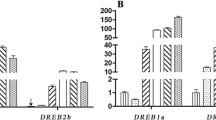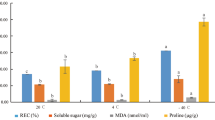Abstract
Key message
We performed a comparative transcriptome combined with morpho-physiological analyses between two differential cold tolerance in two contrasting apricot cultivars. The revealed candidate genes potentially were identified by differential expression analysis.
Apricot (Prunus armeniaca L.) is a major (non-wood product) forest tree species that is adversely affected by spring frost. However, the mechanisms regulating gene expression in response to frost under natural conditions remains relatively uncharacterized. In this study, we analyzed the phenotypic, anatomical, physiological and molecular characteristics of pistils from two apricot cultivars that differ regarding cold tolerance under spring frost. A total of 217,142,216 and 218,148,439 clean reads were obtained for the cold-tolerant (‘Weixuan 1’) and the cold-sensitive (‘Longwangmao’) sample libraries, respectively. Moreover, 57,689 unigenes (≥ 200 bp long) were identified, with an N50 of 2468 bp and a mean length of 1038.08 bp. Furthermore, 1116 up-regulated and 428 down-regulated differentially expressed genes (DEGs) were identified in the two apricot cultivars. Thirteen DEGs related to Ca2+ signaling, four DEGs involved in MAPK cascades, and thirty DEGs encoding transcription factors were affected by spring frost. The most significant transcriptome changes induced by spring frost were related to carbohydrate metabolism, amino acid metabolism, lipid metabolism, secondary metabolites, plant hormone signal transduction, and terpenoid metabolism. Notably, bHLH75, GDSL esterase/lipase EXL3, GDSL esterase/lipase LTL1, and peroxidase-66 were more highly expressed in ‘Weixuan 1’ than in ‘Longwangmao’ under 6:00, suggesting these genes may contribute to the cold tolerance of ‘Weixuan 1’. The reliability of our RNA sequencing results was confirmed by quantitative real-time PCR. The data generated in this study may form the basis of future studies on the mechanisms underlying the cold tolerance of apricot under natural field conditions.







Similar content being viewed by others
References
Alisoltani A, Shiran B, Fallahi H et al (2015) Gene regulatory network in almond (Prunus dulcis Mill.) in response to frost stress. Tree Genet Genomes 11:1–15
An JP, Li R, Qu FJ et al (2018) An apple NAC transcription factor negatively regulates cold tolerance via CBF-dependent pathway. J Plant Physiol 221:74–80
Apel K, Hirt H (2004) Reactive oxygen species: metabolism, oxidative stress, and signal transduction. Annu Rev Plant Biol 55:373–399
Chinnusamy V, Ohta M, Kanrar S et al (2003) ICE1: A regulator of cold-induced transcriptome and freezing tolerance in Arabidopsis. Gene Dev 17:1043–1054
Deng SX, Ma J, Zhang LL et al (2019) De novo transcriptome sequencing and gene expression profiling of Magnolia wufengensis in response to cold stress. BMC Plant Biol 19:1–23
Ding YL, Shi YT, Yang SH (2019) Advances and challenges in uncovering cold tolerance regulatory mechanisms in plants. New Phytol 222:1690–1704
Fadhil AB (2017) Evaluation of apricot (Prunus armeniaca L.) seed kernel as a potential feedstock for the production of liquid bio-fuels and activated carbons. Energ Convers Manag 133:307–317
Frederiks TM, Christopher JT, Harvey GL et al (2012) Current and emerging screening methods to identify post-head-emergence frost adaptation in wheat and barley. J Exp Bot 63:5405–5416
Gómez EM, Buti M, Sargent DJ et al (2019) Transcriptomic analysis of pollen-pistil interactions in almond (Prunus dulcis) identifies candidate genes for components of gametophytic self-incompatibility. Tree Genet Genomes 15:53
Guo XY, Liu DF, Chong K et al (2018) Cold signaling in plants: Insights into mechanisms and regulation. J Integr Plant Biol 60:745–756
Gusta LV, Wisniewski M (2013) Understanding plant cold hardiness: an opinion. Physiol Plantarum 147:4–14
Harel-Beja R, Tian L, Freilich S et al (2019) Gene expression and metabolite profiling analyses of developing pomegranate fruit peel reveal interactions between anthocyanin and punicalagin production. Tree Genet Genomes 15:22
Hiraki H, Uemura M, Kawamura Y et al (2019) Calcium signaling-linked CBF/DREB1 gene expression was induced depending on the temperature fluctuation in the field: views from the natural condition of cold acclimation. Plant Cell Physiol 60:303–317
Hirayama T, Shinozaki K (2010) Research on plant abiotic stress responses in the post-genome era: past, present and future. Plant J 61:1041–1052
Hosseinpour B, Sepahvand S, Aliabad KK et al (2018) Transcriptome profiling of fully open flowers in a frost-tolerant apricot genotype in response to freezing stress. Mol Genet Genom 293:151–163
Hou QC, Ufer G, Bartels D (2016) Lipid signalling in plant responses to abiotic stress. Plant Cell Environ 39:1029–1048
Ji CY, Bian XF, Lee CJ et al (2019) De novo transcriptome sequencing and gene expression profiling of sweet potato leaves during low temperature stress and recovery. Gene 700:23–30
Jia YX, Ding YL, Shi YT et al (2016) The cbfs triple mutants reveal the essential functions of CBFs in cold acclimation and allow the definition of CBF regulons in Arabidopsis. New Phytol 212:345–353
Jiao Y, Shen ZJ, Yan J (2017) Transcriptome analysis of peach [Prunus persica (L.) Batsch] stigma in response to low-temperature stress with digital gene expression profiling. J Plant Biochem Biot 26:141–148
Khadivi A, Montazeran A, Yadegari P (2019) Superior spring frost resistant walnut (Juglans regia L.) genotypes identified among mature seedling origin trees. Sci Hortic 253:147–153
Khan TA, Yusuf M, Ahmad A et al (2019) Proteomic and physiological assessment of stress sensitive and tolerant variety of tomato treated with brassinosteroids and hydrogen peroxide under low-temperature stress. Food chem 2019:500–511
Klay I, Gouia S, Liu M et al (2018) Ethylene response factors (ERF) are differentially regulated by different abiotic stress types in tomato plants. Plant Sci 274:137–145
Knight MR, Campbell AK, Smith SM et al (1991) Transgenic plant aequorin reports the effects of touch and cold-shock and elicitors on cytoplasmic calcium. Nature 352:524–526
Kotrade P, Sehr EM, Wischnitzki E, Brüggemann W (2019) Comparative transcriptomics-based selection of suitable reference genes for normalization of RT-qPCR experiments in drought-stressed leaves of three European Quercus species. Tree Genet Genomes 15:38
Lai CP, Huang LM, Chen LO et al (2017) Genome-wide analysis of GDSL-type esterases/lipases in Arabidopsis. Plant Mol Biol 95:181–197
Li Z, Hu GH, Liu XF et al (2016) Transcriptome sequencing identified genes and Gene Ontologies associated with early freezing tolerance in maize. Front Plant Sci 7:1477
Liu YK, Dang PY, Liu LX et al (2019) Cold acclimation by the CBF-COR pathway in a changing climate: lessons from Arabidopsis thaliana. Plant Cell Rep 38:511–519
Londo JP, Kovaleski AP, Lillis JA (2018) Divergence in the transcriptional landscape between low temperature and freeze shock in cultivated grapevine (Vitis vinifera). Hortic res 5:10
Marina LD, Daniela SS, Jessica B et al (2019) Transcriptomic response of durum wheat to cold stress at reproductive stage. Mol Biol Rep 46:2427–2445
Montero-Palmero MB, Martín-Barranco A, Escobar C et al (2014) Early transcriptional responses to mercury: a role for ethylene in mercury-induced stress. New Phytol 201:116–130
Qi JS, Song CP, Wang BS et al (2018) Reactive oxygen species signaling and stomatal movement in plant responses to drought stress and pathogen attack. J Integr Plant Biol 60:805–826
Song LL, Jiang L, Chen Y et al (2016) Deep-sequencing transcriptome analysis of field-grown Medicago sativa L. crown buds acclimated to freezing stress. Funct Integr Genomic 16:495–511
Stryjecka M, Kieltyka-Dadasiewicz A, Michalak M et al (2019) Chemical composition and antioxidant properties of oils from the seeds of five apricot (Prunus armeniaca L.) cultivars. J Oleo Sci 68:729–738
Townley HE, Knight MR et al (2002) Calmodulin as a potential negative regulator of Arabidopsis COR gene expression. Plant Physiol 128:1169–1172
Wang L, Du H, Li T, Wuyun TN (2017) De novo transcriptome sequencing and identification of genes related to salt stress in Eucommia ulmoides Oliver. Trees 32:1–13
Wang P, Li YH, Zhang XM et al (2013) Effect of low temperature stress on ascorbate-glutathione cycle in kernel apricot pistil. Acta Horticult Sin 40:15–23
Yadav AK, Pal A, Dubey AM (2018) Experimental Studies on Utilization of Prunus armeniaca L. (Wild Apricot) Biodiesel as an Alternative Fuel for CI Engine. Waste Biomass Valor 9:1961–1969
Ye J, Han WJ, Deng P et al (2019) Comparative transcriptome analysis to identify candidate genes related to chlorogenic acid biosynthesis in Eucommia ulmoides Oliv. Trees 33:1373–1384
Yoo SD, Cho YH, Tena G et al (2008) Dual control of nuclear EIN3 by bifurcate MAPK cascades in C2H4 signalling. Nature 451:789–795
Yuan PG, Yang TB, Poovaiah BW (2018) Calcium signaling-mediated plant response to cold stress. Int J Mol Sci 19:3896
Zhang ZY, Li JH, Li F et al (2017) OsMAPK3 phosphorylates OsbHLH002/OsICE1 and inhibits its ubiquitination to activate OsTPP1 and enhances rice chilling tolerance. Dev Cell 43:731–743
Zhao CZ, Wang PC, Si T et al (2017) MAP kinase cascades regulate the cold response by modulating ICE1 protein stability. Dev Cell 43:618–629
Zhao CZ, Zhang ZJ, Xie SJ et al (2016) Mutational evidence for the critical role of CBF transcription factors in cold acclimation in Arabidopsis. Plant Physiol 171:2744–2759
Zhao DQ, Zhang XY, Fang ZW et al (2019) Physiological and transcriptomic analysis of tree peony (Paeonia section Moutan DC) in response to drought stress. Forests 10:135
Zhou CJ, Cai ZH, Guo YF (2009) An Arabidopsis mitogen-activated protein kinase cascade, MKK9-MPK6, plays a role in leaf senescence. Plant Physiol 150:167–177
Acknowledgments
This work was financially supported by the Central Public-Interest Scientific Institution Basal Research Fund (CAFYBB2020ZY003, CAFYBB2019SY005 and CAFYBB2017ZA004). We thank the Apricot Germplasm Resources Orchard (Shanxi, China) for providing the apricot samples and Liwen Bianji, Edanz Editing China (www.liwenbianji.cn/ac) for editing the English text of a draft of this manuscript.
Author information
Authors and Affiliations
Corresponding author
Ethics declarations
Conflict of interest
The authors declare that they have no conflict interests.
Data archiving statement
The raw sequencing data are archived in NCBI No.PRJNA590556.
Additional information
Communicated by Francisco M. Cánovas.
Publisher's Note
Springer Nature remains neutral with regard to jurisdictional claims in published maps and institutional affiliations.
Electronic supplementary material
Below is the link to the electronic supplementary material.
Rights and permissions
About this article
Cite this article
Yu, D., Liu, X., Cui, Y. et al. Comparative transcriptome combined with morpho-physiological analyses revealed candidate genes potentially for differential cold tolerance in two contrasting apricot (Prunus armeniaca L.) cultivars. Trees 34, 1205–1217 (2020). https://doi.org/10.1007/s00468-020-01991-y
Received:
Accepted:
Published:
Issue Date:
DOI: https://doi.org/10.1007/s00468-020-01991-y




